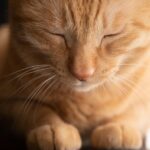The Complete Guide to Homemade Balanced Diets for Nursing Cats: Nourishing Momma & Kittens
Bringing a new litter of kittens into the world is a demanding job for any feline. A nursing cat (also known as a queen) requires significantly more calories, protein, and other essential nutrients than a regular adult cat. During this crucial period, proper nutrition is paramount not only for her well-being and recovery but also for the healthy growth and development of her kittens. While high-quality commercial kitten food is a viable option, many cat owners prefer the control and assurance that comes with preparing a homemade balanced diet.
This comprehensive guide will walk you through everything you need to know about creating a safe, nutritious, and palatable homemade diet for your nursing cat. We’ll cover essential nutrients, suitable ingredients, balanced recipes, safety considerations, and monitoring guidelines.
Why Consider a Homemade Diet for Your Nursing Cat?
There are several reasons why you might choose to prepare a homemade diet for your nursing queen:
- Ingredient Control: You have complete control over the ingredients, ensuring they are high-quality and free from unwanted additives, fillers, or allergens.
- Personalized Nutrition: You can tailor the diet to your cat’s specific needs and preferences, adjusting the recipe based on her individual health status and the size of her litter.
- Addressing Allergies or Sensitivities: If your cat has known allergies or sensitivities to certain ingredients found in commercial foods, a homemade diet allows you to eliminate those triggers.
- Enhanced Palatability: Some cats find homemade food more palatable than commercial food, encouraging them to eat more and meet their increased nutritional needs.
- Peace of Mind: For some owners, the peace of mind that comes from knowing exactly what their cat is eating is invaluable.
Important Considerations Before Starting a Homemade Diet:
Before diving into homemade cat food recipes, it’s crucial to understand the potential challenges and take necessary precautions.
- Nutritional Completeness is Key: Cats have specific nutritional requirements that are different from humans and even dogs. A homemade diet must be nutritionally complete and balanced to avoid deficiencies that can lead to serious health problems. Simply throwing together some meat and vegetables is not sufficient and can be detrimental to your cat’s health.
- Consult with a Veterinary Nutritionist: The most important step is to consult with a board-certified veterinary nutritionist. They can assess your cat’s individual needs, help you create a personalized recipe, and ensure it meets all the necessary nutritional requirements for lactation. They can also provide guidance on proper supplementation.
- Time Commitment: Preparing homemade cat food requires a significant time commitment for planning, shopping, cooking, and proper storage.
- Food Safety: Proper food handling and storage are critical to prevent bacterial contamination and ensure the safety of the food.
- Cost: Depending on the ingredients you choose, a homemade diet can be more expensive than high-quality commercial food.
- Gradual Transition: If your cat is currently eating commercial food, you’ll need to transition her to the homemade diet gradually over a period of several days to avoid digestive upset.
Essential Nutrients for Nursing Cats:
A nursing cat needs a diet rich in the following nutrients:
- Protein: Protein is crucial for tissue repair, milk production, and the growth of the kittens. Nursing cats require significantly more protein than adult cats, ideally from high-quality animal sources.
- Fat: Fat provides energy and is essential for the absorption of fat-soluble vitamins. Nursing cats need a higher fat intake to support milk production and maintain their energy levels.
- Carbohydrates: While cats are obligate carnivores and don’t require large amounts of carbohydrates, a small amount can provide energy and fiber. Choose easily digestible sources like cooked sweet potato or pumpkin.
- Taurine: Taurine is an essential amino acid that cats cannot produce themselves. It’s crucial for heart health, vision, and reproductive function. Ensure your diet includes adequate taurine, typically from meat sources or through supplementation.
- Calcium and Phosphorus: These minerals are essential for bone development and milk production. A balanced calcium-to-phosphorus ratio is crucial to prevent skeletal problems in both the mother and kittens.
- Vitamins: Vitamins A, D, E, and B vitamins are essential for various bodily functions. Ensure your diet includes adequate levels of these vitamins through a balanced combination of ingredients or through supplementation.
- Minerals: In addition to calcium and phosphorus, other essential minerals include iron, zinc, copper, and manganese.
Suitable Ingredients for a Homemade Diet:
Here’s a list of ingredients that can be included in a homemade diet for nursing cats, along with important considerations:
Animal Protein Sources:
- Chicken: A good source of lean protein, easily digestible. Remove skin to reduce fat content if necessary.
- Turkey: Another lean protein source, similar to chicken.
- Beef: Provides protein and iron. Choose lean cuts.
- Lamb: A good source of protein and fat.
- Fish (Salmon, Sardines): Excellent sources of omega-3 fatty acids, which are beneficial for brain development and immune function. Choose boneless, skinless options. Limit the amount of fish due to potential mercury contamination and thiaminase content (which can deplete thiamine). Sardines packed in water are a good choice, as they contain edible bones that are a source of calcium.
- Organ Meats (Liver, Heart): Highly nutritious, packed with vitamins and minerals. Include in moderation, as they are very rich. Liver is a good source of Vitamin A, but too much can be toxic.
- Eggs: A complete protein source. Cooked eggs are a good addition to the diet.
Carbohydrate Sources:
- Cooked Sweet Potato: A good source of fiber and vitamins.
- Cooked Pumpkin: Provides fiber and can help with digestion.
- Cooked White Rice: An easily digestible carbohydrate source, but offers limited nutritional value.
Fat Sources:
- Fish Oil: Provides omega-3 fatty acids.
- Chicken Fat: A readily available and palatable source of fat. Use in moderation.
- Coconut Oil: Contains medium-chain triglycerides (MCTs) which can be beneficial, but use sparingly.
Other Beneficial Ingredients:
- Bone Broth: Provides collagen, minerals, and amino acids.
- Brewer’s Yeast: A good source of B vitamins.
- Kelp Powder: Provides iodine, essential for thyroid function.
- Taurine Supplement: Essential for all cats, especially nursing cats. Ensure your recipe contains adequate taurine levels, and supplement if necessary.
Ingredients to Avoid:
- Raw Meat or Fish: Can contain harmful bacteria that can cause illness.
- Bones (Cooked): Can splinter and cause injury to the digestive tract.
- Grapes and Raisins: Toxic to cats.
- Onions and Garlic: Toxic to cats.
- Chocolate: Toxic to cats.
- Avocado: Can be toxic to cats.
- Dairy Products (Milk): Many cats are lactose intolerant and can experience digestive upset.
- Dog Food: Not formulated to meet the specific nutritional needs of cats.
- Salty or Sugary Foods: Unhealthy and can lead to health problems.
- Alcohol: Extremely toxic to cats.
Sample Homemade Recipe for Nursing Cats (Consult a Veterinary Nutritionist Before Implementing):
Disclaimer: This is a sample recipe for informational purposes only and is not a substitute for professional veterinary advice. You must consult with a board-certified veterinary nutritionist to develop a personalized recipe that meets your cat’s individual needs.
Recipe: Chicken & Sweet Potato Mix (Adjust Quantities Based on Veterinary Nutritionist’s Recommendations)
Ingredients:
- 2 lbs Boneless, Skinless Chicken Breast (cooked and shredded)
- 1 lb Cooked Sweet Potato (mashed)
- 4 oz Chicken Liver (cooked and finely chopped)
- 2 oz Sardines in Water (boneless, skinless)
- 2 tbsp Fish Oil (salmon oil is a good option)
- 1 tbsp Brewer’s Yeast
- 1 tsp Kelp Powder
- Taurine Supplement (dosage as recommended by your veterinary nutritionist)
Instructions:
- Cook chicken breast thoroughly by baking, boiling, or steaming. Shred or dice into small pieces.
- Cook sweet potato until soft. Mash thoroughly.
- Cook chicken liver until thoroughly cooked and finely chop or mince.
- Combine all ingredients in a large bowl and mix thoroughly.
- Divide into appropriate portion sizes based on your cat’s needs and store in the refrigerator or freezer.
Feeding Guidelines:
- Frequency: Nursing cats need to eat frequently throughout the day. Offer small, frequent meals (4-6 times per day) to ensure they are getting enough calories.
- Quantity: The amount of food your nursing cat needs will vary depending on her size, breed, age, and the size of her litter. Start with approximately 2-3 times the amount of food she was eating before pregnancy. Your veterinary nutritionist can provide more specific guidance.
- Monitor Weight: Regularly monitor your cat’s weight to ensure she is maintaining a healthy body condition. She should be gaining or maintaining weight, not losing it.
- Fresh Water: Always provide access to fresh, clean water. Nursing cats need plenty of water to stay hydrated.
- Introduce to Kittens (Later): As the kittens start to wean (around 4-6 weeks), you can gradually introduce them to the same homemade food, pureed or finely chopped.
Food Safety Practices:
- Wash Hands Thoroughly: Wash your hands thoroughly with soap and water before and after preparing cat food.
- Use Clean Utensils and Surfaces: Use clean cutting boards, knives, and bowls for preparing cat food. Sanitize surfaces regularly.
- Cook Meat Thoroughly: Ensure all meat is cooked to a safe internal temperature to kill harmful bacteria.
- Store Food Properly: Store homemade cat food in the refrigerator for up to 2-3 days, or in the freezer for up to 2-3 months.
- Defrost Safely: Defrost frozen food in the refrigerator, not at room temperature.
- Discard Leftovers: Discard any uneaten food after 24 hours.
Monitoring Your Nursing Cat’s Health:
- Appetite: Monitor your cat’s appetite. A decrease in appetite can be a sign of illness.
- Weight: Regularly weigh your cat to ensure she is maintaining a healthy weight.
- Body Condition: Assess your cat’s body condition. She should have a visible waist and you should be able to feel her ribs easily.
- Stool Consistency: Monitor your cat’s stool consistency. Diarrhea or constipation can be a sign of dietary problems or illness.
- Milk Production: Check your cat’s mammary glands regularly to ensure she is producing enough milk.
- Kitten Health: Monitor the kittens’ growth and development. They should be gaining weight steadily and appear healthy.
When to Consult a Veterinarian:
Contact your veterinarian immediately if you notice any of the following signs in your nursing cat or her kittens:
- Loss of appetite
- Weight loss
- Vomiting or diarrhea
- Lethargy
- Difficulty breathing
- Discharge from the eyes or nose
- Swollen or painful mammary glands
- Failure to thrive in kittens
Conclusion:
Preparing a homemade balanced diet for a nursing cat can be a rewarding experience, allowing you to provide her and her kittens with optimal nutrition. However, it’s crucial to approach this task with careful planning, a thorough understanding of feline nutritional needs, and the guidance of a qualified veterinary nutritionist. By following these guidelines and working closely with your veterinarian, you can ensure that your nursing cat receives the nutrients she needs to thrive and raise a healthy litter of kittens. Remember, prioritizing your cat’s health and safety is paramount.
This information is for educational purposes only and does not substitute professional veterinary advice. Always consult with a qualified veterinary nutritionist before making changes to your cat’s diet. Good luck!
Featured Image Credit: Pixabay


